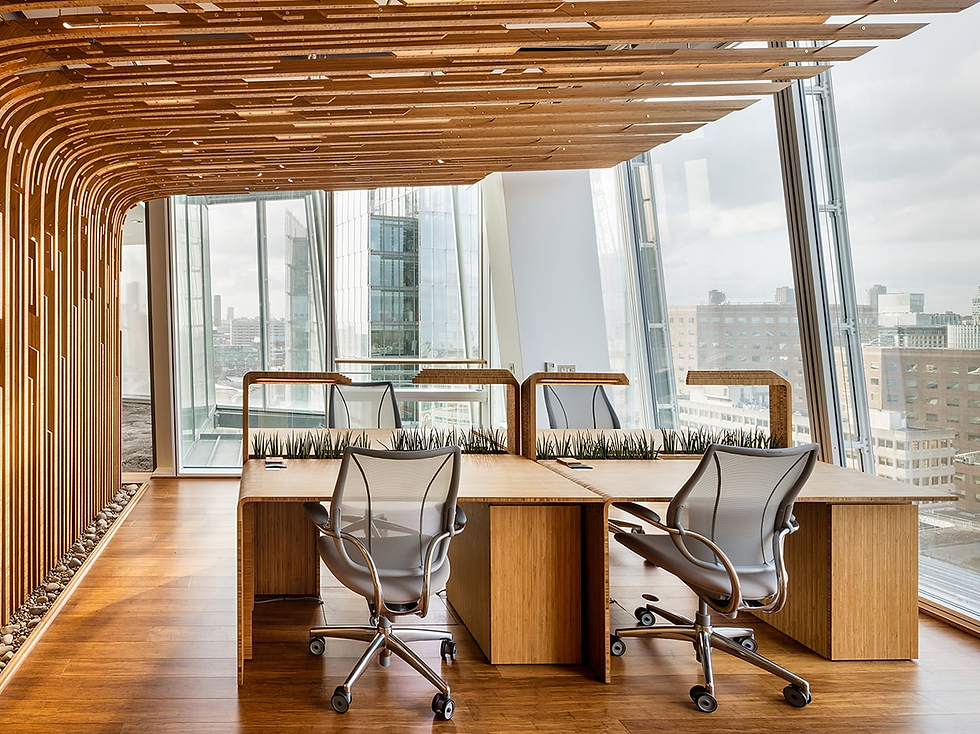Crafting Tomorrow: The Rise of Reusable Interiors
- Drake+Khan Design

- Feb 5, 2024
- 3 min read
© Kyungsub Shin Photography / DaeWha Kang Design / Mitie PLC, Company Headquarters, Experimental Workspace
As the world increasingly embraces sustainability, the interior design industry is transforming its eco-conscious practices. A notable trend within this shift is the emergence of reusable interiors—spaces designed with materials that can be disassembled and repurposed in the future. This departure from conventional practices not only aligns with the urgent call for eco-responsibility but also represents a transformative approach to design that seeks to minimize waste, encourage resource efficiency, and contribute to a circular economy, showcasing how forward-thinking design can pave the way for a more sustainable and adaptable future.
Benefits of Reusable Interiors:
The rise of reusable interiors brings forth a host of benefits, aligning with the broader goals of sustainability within the design industry. Some examples are:
Reduced Environmental Impact: By utilizing materials that can be disassembled and reused, these projects significantly reduce the environmental impact associated with construction and interior design. This approach minimizes waste and promotes a more responsible use of resources.
Encourage Circular Economy Practices: Reusable interiors contribute to the concept of a circular economy where materials are continuously cycled and repurposed. This not only extends the lifespan of materials but also reduces the demand for new resources.
Allow for Adaptability: The flexibility of reusable interiors enables spaces to evolve, adapt, and meet changing needs over time. This adaptability is crucial in a world where functionality and design preferences may shift.
Set a Sustainable Design Standard: Projects like those mentioned above set a new standard for sustainable interior design, inspiring industry professionals to prioritize environmentally friendly practices in their projects.
Real-World Examples
Oslotre's Timber Office
© Einar Aslaksen Photography / Oslotre / HasleTre, Oslo, Norway
Oslotre, a pioneering design firm in Norway, has taken a bold step towards creating a circular economy with its timber office project. This demountable structure serves as a "material bank," where every component can be easily disassembled and reused. The use of timber not only aligns with the principles of sustainability, but the demountable design ensures that each element retains its value, contributing to a future where materials are a valuable resource to be repurposed rather than discarded.
Universal Design Studio and Giles Miller Studio's Reusable Pavilion for BBC
© Universal Design Studio / Giles Miller Studio / BBC Studios Pavillion
In a collaboration that blends innovation with sustainability, Universal Design Studio and Giles Miller Studio have designed a reusable pavilion for the BBC. This forward-thinking project demonstrates the potential for creating temporary structures that can be disassembled and repurposed for future events. The pavilion showcases a commitment to reducing environmental impact by minimizing waste associated with one-time-use structures, setting a precedent for the events industry to embrace more sustainable practices.
Domino Architects' Reusable Sales Showroom
© Gottingham Photography / Domino Architects / PROUD Gallery Showroom, Japan
Domino Architects has embraced the concept of reusable interiors by dividing a sales showroom with fabric walls that can be easily taken down and reconfigured. This project exemplifies flexibility in interior design, allowing for spaces to evolve and adapt to changing needs. The use of fabric walls not only adds a tactile and dynamic element to the showroom but also promotes a sustainable approach by reducing the need for permanent, resource-intensive construction.
Conclusion:
The era of reusable interiors marks a paradigm shift in the interior design industry, emphasizing the importance of sustainable, adaptable spaces. As projects like Oslotre's timber office, the BBC pavilion by Universal Design Studio and Giles Miller Studio, and Domino Architects' sales showroom showcase, the future of interior design lies in creations that not only captivate aesthetically but also embody a commitment to the responsible use of resources for a more sustainable world. Reusable interiors are not just a trend; they represent a fundamental shift towards a more conscious and sustainable future.








Comentarios